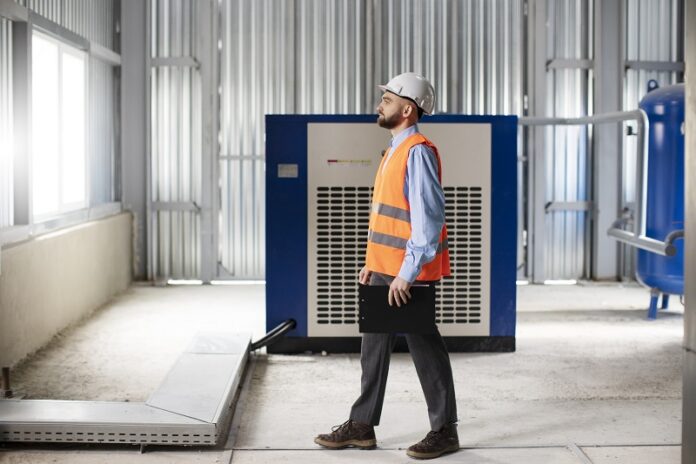
Heating, ventilation, and air conditioning (HVAC) systems play a crucial role in maintaining comfort, indoor air quality, and energy efficiency in commercial buildings. Optimizing performance involves careful equipment selection, ductwork design, and adopting energy-efficient practices. This comprehensive guide will discuss various strategies for enhancing HVAC operations to create healthy and productive indoor environments.
It stands for Heating, Ventilation, and Air Conditioning. It is the technology of indoor and vehicular environmental comfort.
The HVAC system design is a subdiscipline of mechanical engineering, based on the principles of thermodynamics, fluid mechanics, and heat transfer.
Some key aspects includes:
- Heating – Provides warmth to maintain set temperatures for comfort and safety. Utilizes furnaces, boilers, heat pumps, etc.
- Ventilation – Brings in outdoor air and removes indoor air via fans and ductwork. Ensures air quality.
- Air Conditioning – Cools and dehumidifies air for thermal comfort. Uses compressors, condensers, evaporators etc.
- Filtration – Removes airborne particles through filters to clean air.
- Humidification – Increases moisture levels in the air to maintain comfortable humidity.
- Controls – Thermostats, switches, and sensors to regulate system operation and temperatures.
- Distribution – Ductwork distributes heated, cooled, and conditioned air through the building.
- Testing & Balancing – Commissioning and adjusting systems for optimal airflows, efficiency, and comfort.
HVAC involves the equipment, distribution systems, and processes used to achieve indoor air quality, thermal comfort, and ventilation for the built environment. Managing heating, cooling, humidity, and air movement ensures healthy, productive indoor spaces.
The Importance of Efficient HVAC Systems
HVAC units provide heating, cooling, and ventilation to maintain thermal comfort. They regulate humidity, filter air pollutants, and introduce outdoor air into buildings. High-performing HVAC systems are critical for:
- Indoor Air Quality – Well-designed systems filter out contaminants and facilitate air exchange to provide clean, breathable air. This promotes occupant health and productivity.
- Energy Efficiency – Optimized HVAC operation reduces energy consumption, lowering utility bills. Enhanced efficiency also decreases the environmental impact.
- Comfort – Effective temperature, humidity, and ventilation control creates comfortable conditions for building occupants.
- Cost Savings – Increased efficiency saves long-term costs through lower energy usage and maintenance requirements.
How Does HVAC Efficiency Impact Businesses?
The performance of HVAC systems directly impacts building operations and the bottom line:
- Employee Productivity – Comfortable indoor environments correlate to higher worker performance and satisfaction.
- Operating Costs – It can account for over 40% of a commercial building’s energy use. Increased efficiency significantly reduces expenses.
- Equipment Lifespan – Well-maintained HVAC systems last longer, reducing capital costs for replacement.
- Sustainability – Improved efficiency decreases a building’s carbon footprint and supports corporate sustainability goals.
- Indoor Air Quality – Enhanced filtration and ventilation improves air quality to protect employee health.
Also read: Capacity Utilization Formula and Metrics: An Expert Guide for Manufacturers
Factors That Influence HVAC Efficiency
Several important factors determine how efficiently an system operates:
Equipment Sizing and Placement
- HVAC units must be properly sized for each space’s heating/cooling load. Oversized equipment operates inefficiently.
- Strategic placement is needed for even conditioning and airflow.
Ductwork Design
- Tight, well-insulated ductwork prevents leaks for proper air delivery. Sealing and insulating ducts enhance efficiency.
Maintenance and Cleaning
- Dirty components like coils and air filters increase resistance. Regular maintenance improves airflow.
Environmental Factors
- Poor insulation, air leaks, and solar gain make cooling/heating more energy intensive.
System Controls
- Advanced controls like zone sensors and smart thermostats optimize efficiency.
Optimizing Equipment Placement and Airflow
The location of HVAC components impacts system performance. Follow these guidelines for positioning:
Outdoor Condensing Units
- Place condenser units away from exhaust vents to avoid air recirculation.
- Ensure sufficient airflow clearance around the unit.
- Install units on concrete pads to prevent damage and vibration.
Air Handling Units
- Central air handlers should be located centrally to serve multiple zones.
- Avoid installation in unconditioned spaces like attics.
- Place near main duct trunk lines to reduce static pressure losses.
Vents and Registers
- Locate ceiling supply vents above exterior walls to support air circulation.
- Avoid placing registers near thermostats which can cause inaccurate readings.
- Adjust registers to prevent short cycling of conditioned air.
Return Air Vents
- Position returns high on walls to remove rising warm air.
- Place returns far from supply vents to facilitate air mixing.
Outdoor Air Intakes
- Intakes should be on the north side away from exhaust vents.
- Locate intakes at least 10 feet from contaminant sources like driveways.
- Place intakes above ground to supply cleaner air.
Ductwork Design for Efficiency
Ductwork distributes conditioned air throughout the building. Optimized ducts enhance HVAC performance.
Air Tight Ductwork
Leaky ducts allow conditioned air to escape, wasting energy. Ensure ductwork is air tight by:
- Sealing all seams and connections with mastic or metal tape.
- Inspecting ducts regularly for leaks and re-sealing as needed.
- Supporting ducts properly to prevent sagging and separation.
Proper Duct Sizing
Ducts that are oversized or undersized cause airflow issues. Ducts should be sized according to:
- Airflow demands of the building zones.
- Length of duct runs.
- Number of turns/bends.
- Total system static pressure.
Insulated Ductwork
Insulation reduces heat transfer through duct walls, preserving air temperature.
- Use duct wrap or closed-cell insulation with at least R-8 insulation value.
- Insulate ducts in unconditioned spaces like attics.
- Ensure insulation is sealed properly at all seams.
Duct Cleaning
Regular duct cleaning removes accumulated dust, dirt, and debris. This improves airflow and indoor air quality.
Achieving Thermal Comfort
Maintaining thermal comfort ensures occupant satisfaction. Follow these tips:
Follow Industry Standards
Adhere to thermal comfort guidelines from ASHRAE Standard 55 which include:
- Temperature between 68°F – 75°F.
- Relative humidity between 30% – 60%.
Prioritize Air Movement
Gentle air movement through overhead fans or HVAC systems helps cool people by accelerating evaporation.
Allow Personal Adjustments
Provide occupant controls like thermostats and operable windows for personalized adjustments.
Monitor Conditions
Use sensors to monitor temperature, humidity, and airflow. Make adjustments as needed.
Consider Radiant Heating/Cooling
Radiant systems heat/cool surfaces directly, creating comfort at lower air temperatures.
Maintaining Good Indoor Air Quality
The EPA estimates indoor air is 2 to 5 times more polluted than outdoor air. HVAC systems should facilitate air exchange and filtration.
Meet Minimum Ventilation Rates
ASHRAE 62.1 sets whole-building and zone-level minimum outdoor air requirements for acceptable IAQ.
Control Humidity
Keep relative humidity between 30% – 60%. Lower humidity reduces mold/mildew growth.
Install MERV 13+ Air Filters
High-efficiency MERV 13+ filters effectively remove airborne particles like dust and allergens.
Monitor Carbon Dioxide
CO2 sensors indicate if outdoor air ventilation rates are sufficient.
Ensure Exhaust Fans Operate Properly
Properly functioning restroom/kitchen exhaust fans remove odor and contaminants.
Energy Conservation Strategies
Several approaches can reduce HVAC energy consumption:
System Commissioning
Commissioning ensures that its components interact properly for peak efficiency.
Airflow Preservation
Regular filter changes, coil cleaning, and duct cleaning maintain airflow.
Insulation Improvements
Ensure insulation meets code requirements. Upgrade attic/roof insulation to reduce heat transfer.
Eliminate Simultaneous Heating/Cooling
Engineered HVAC controls prevent zones from simultaneous heating and cooling.
Set Back Thermostats
Programmable thermostats reduce temperatures when spaces are unoccupied.
Economizer Mode
Economizers use cool outdoor air for free cooling when conditions permit.
Demand Control Ventilation
CO2 sensors modulate ventilation rates based on occupancy, reducing energy waste.
HVAC Installation and Replacement
Proper installation is critical for HVAC systems to operate safely and efficiently. There are several considerations when installing new HVAC equipment:
Sizing
The system must be appropriately sized for the building’s heating and cooling load. Oversized units lead to short cycling and inefficiency. Load calculations should be performed to select the proper capacity.
Equipment Selection
Choose high-efficiency equipment that meets current energy standards like Energy Star. Consider variables like climate and utility costs.
Placement
Position components like air handlers, condenser units, vents and ducts according to the tips provided earlier for optimal airflow and efficiency.
Ductwork
Install ducts to minimize length, bends, and airflow restrictions. Use mastic to seal all duct joints airtight. Insulate all ductwork to prevent condensation and heat gain/loss.
Drainage
Install condensate pumps and routes for proper drainage of condensate produced during cooling operation.
Venting
Vent combustion appliances properly to safely exhaust carbon monoxide outside.
Commissioning
Have a certified HVAC technician confirm the correct system operation. Perform necessary air balancing, control calibration, etc.
HVAC Replacement
HVAC systems have a typical lifespan of 10-15 years. Replacement is necessary when:
- Equipment is no longer cost-effective to maintain/repair
- Parts are difficult to obtain
- Energy efficiency no longer meets the code
- Components are damaged beyond repair
- Indoor air quality is compromised
When replacing HVAC systems:
- Consider upgrading to higher efficiency systems to maximize energy savings
- Replace ductwork that is damaged or leaks air
- Select equipment sized specifically for the building based on accurate heating/cooling load calculations
- Dispose of old refrigerant and equipment properly per EPA guidelines
- Have a certified technician install and commission the new system
Following proper installation and replacement practices helps sustain HVAC performance and indoor comfort.
Information on HVAC certifications:
Its technicians have several certification options to demonstrate competency and skills. Some of the major HVAC certifications include:
EPA Section 608 Certification
This is mandatory for anyone handling refrigerants during the service, repair, or disposal of HVAC systems. Technicians must pass an EPA-approved test on safe refrigerant handling.
HVAC Excellence
HVAC Excellence offers several certifications for various specialties:
- Heating (CH)
- Electrical (CE)
- Air Conditioning (AC)
- Heat Pumps (HP)
- Gas Furnaces (CG)
NATE – North American Technician Excellence
NATE certification is well-recognized and confirms knowledge in:
- Installation
- Service
- Repair
- Design
Certification is available for 25 specialties from air distribution to hydronics gas.
RSES – Refrigeration Service Engineers Society
RSES offers over 30 HVACR certification exams testing real-world job skills. Focus areas range from commercial refrigeration to its system cleaning.
UA STAR Certification – United Association
The UA STAR exam certifies expertise in heating, piping, cooling, and plumbing. It is required for technicians entering UA apprenticeship programs.
Green Mechanical Systems Certification
This demonstrates expertise in installing and servicing green technologies like geothermal heat pumps, solar thermal systems, etc.
Earning relevant HVAC certifications demonstrates competency. Many licensing jurisdictions and employers require certification as well. Investing in a strong certification portfolio can boost career advancement opportunities and salary potential.
Here are some tips for finding HVAC jobs:
- Search job sites and aggregators like Indeed, Monster, ZipRecruiter, etc. for openings. Use relevant keywords like “HVAC technician”, “AC installer”, “ductwork installer” etc.
- Look for openings on HVAC company websites. Major firms like Carrier, Trane, Rheem, etc. often list technician jobs.
- Check for openings on local union websites. Many HVAC workers belong to trade unions that post apprenticeships and jobs.
- Attend job fairs for the skilled trades. Connect with HVAC companies recruiting at these events.
- Leverage social media networks like LinkedIn to find roles. Follow HVAC companies and interact with their posts about openings.
- Check listings on Craigslist under Skilled Trade/Craft jobs. Individual contractors often list opportunities there.
- Inquire with HVAC suppliers and wholesale distributors about contractor job leads.
- Register with its technician staffing agencies who can match you with assignments.
- Talk to professors and advisors at trade schools with HVAC programs about job assistance.
- Apply for apprenticeship programs to get trained on the job. Unions and contractors often sponsor these.
- Consider temporary assignments to gain experience. Sign up with staffing firms specializing in skilled trades.
- Network with its technicians and contractors at industry events and trade shows.
Persistence and continuously checking all these sources is key when looking for that first HVAC job opportunity. Gain additional training and certifications to make your resume more attractive to potential employers as well.
HVAC FAQs:
What do it stand for?
HVAC stands for Heating, Ventilation, and Air Conditioning. It’s the building system that regulates indoor air quality, temperature, and humidity.
How often should I replace HVAC air filters?
For residential systems, air filters should typically be replaced every 1-3 months. Commercial buildings may need monthly filter changes. Check filters monthly and replace them when dirty.
Why does my system blow cold air sometimes when heating?
This is caused by the system defrosting itself. The outdoor unit periodically reverses the refrigerant flow to melt frost buildup on coils. This takes 5-10 minutes before reheating.
What temperature should I set my thermostat to?
Ideal thermostat temperatures range from 68-75° F in winter and 72-79° F in summer depending on humidity. Adjust as needed for comfort.
How can I balance my HVAC system?
Hire an HVAC technician to balance air and water flow. This involves adjusting dampers, valves, fans speeds and vents to optimize efficiency.
What is involved in HVAC maintenance?
Typical maintenance includes replacing filters, cleaning coils and drains, inspecting components, checking refrigerant charge, testing controls, and verifying proper airflow.
Why does my HVAC make loud noises?
Loud systems often have loose parts, imbalances, or failing components. Have a technician inspect and diagnose noises right away.
How often should I have my HVAC inspected?
It systems should be professionally inspected at least annually. Biannual inspections are better for older systems or units running extensively.
What does the It tune-up service include?
Tune-ups involve cleaning, inspection, filter/belt changes, leak checks, vent inspection, testing controls, and checking refrigerant charge/pressure.
Conclusion
Optimizing HVAC placement, airflow, and efficiency provides healthier and more comfortable indoor environments. Air-tight ductwork, regular maintenance, and smart controls also improve efficiency to reduce costs and environmental impact. By following the strategies outlined in this guide, businesses can enhance HVAC performance to benefit building occupants and the bottom line.











